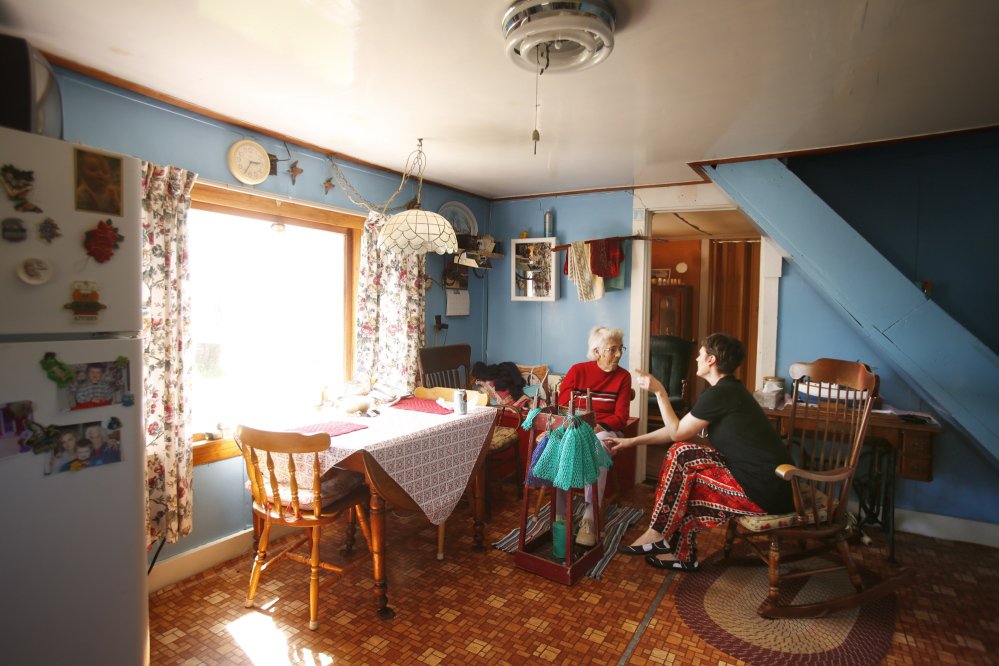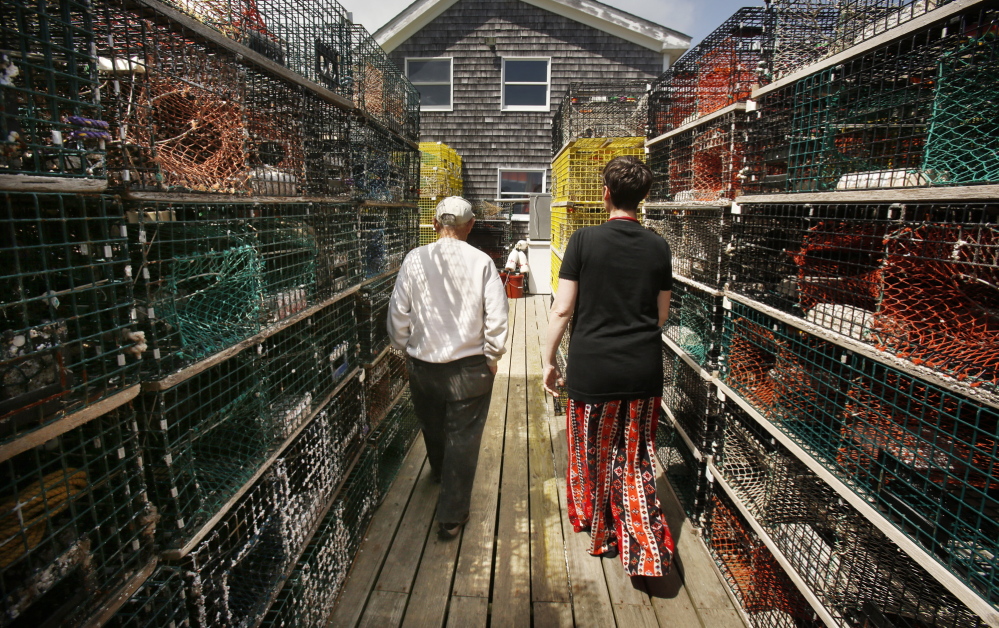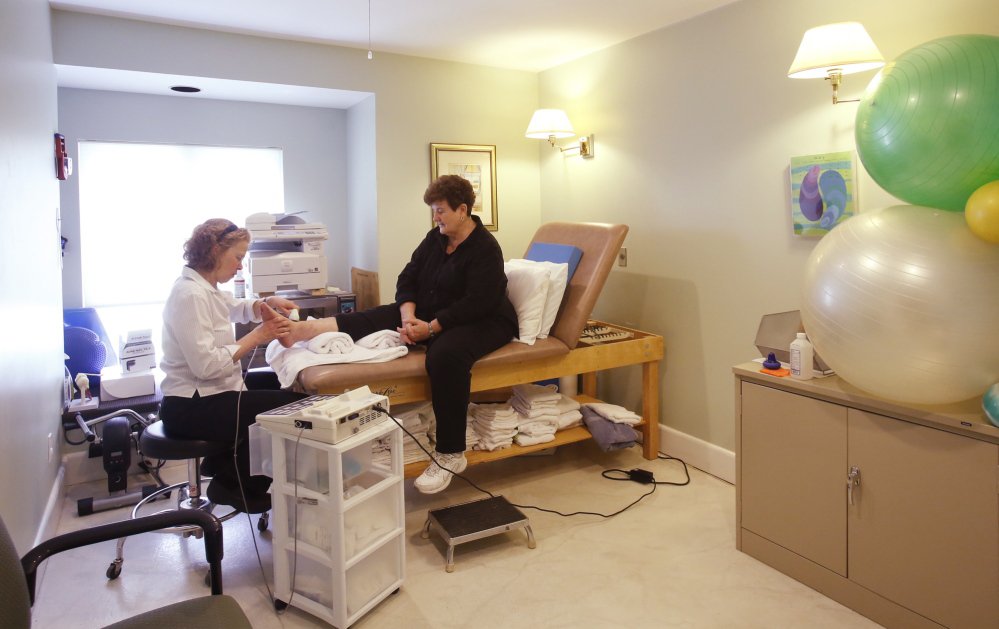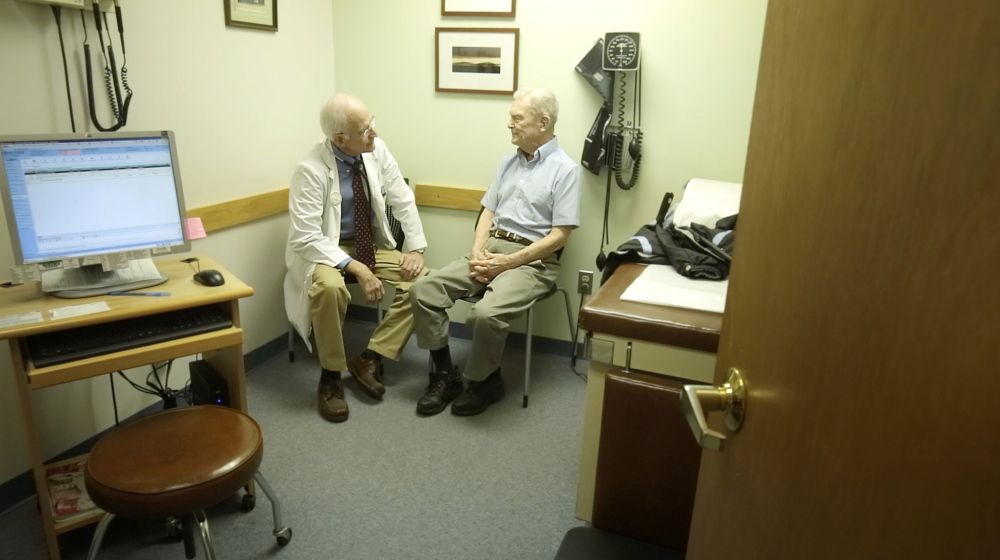Jennifer Desmond stood in the middle of Vinalhaven island’s Old Harbor Road on a January day. The cold rain and fierce wind chafed her face as she helped paramedics respond to a car accident.
Desmond – a nurse practitioner and the island’s unofficial comforter-in-chief – should have been home with her feet up sipping hot chocolate on that day in 2012. She was nine months pregnant, and it was her official due date. But Desmond needed to work because the island was short on doctors, a common occurrence during her eight years on the island.
“It was crazy, but it was crazy all the time,” Desmond, 41, said last week, recalling a period when her life was filled with 16-hour workdays and weeks without a day off. “I can’t tell you how many times I would go home, take my shoes off and immediately my pager would go off.”
Vinalhaven and other rural areas of Maine often suffer shortages in primary care, and the problem is expected to worsen in the coming decades unless action is taken, authorities say. Physicians are aging and not enough young doctors are willing to locate to small towns or the countryside to pursue a career in primary care when they are laden with big medical school bills and would receive significantly less pay than their specialized peers.
The trends cut against rural medicine in Maine and elsewhere:
n Maine’s distribution of primary care physicians is wildly uneven, with a disproportionate number choosing to practice near Portland. In Cumberland County, there were 163 primary care doctors per 100,000 people in 2010, the latest numbers available, according to the federal data. In more rural counties, the per capita rate is less than half that: 45.7 in Washington, 53.6 in Oxford, 65.2 in Sagahadoc, and 65.1 in Somerset. The national average is 90.5 primary care doctors per 100,000, according to the Association of American Medical Colleges.
n Fewer medical school students are going into primary care. The number of doctors choosing primary care training programs declined nationally from 3,293 in 1998 to 2,730 in 2011, according to the University of Washington Rural Health Research Center. Specialists earn far higher salaries than family doctors.
n Many recent medical school graduates belong to a generation that increasingly shuns rural areas when choosing where to live. Nearly 90 percent of millennials, roughly those in the 18-34 age bracket, want to live in urban places, according to a 2012 survey by the Robert Charles Lesser and Co. real estate firm. Surveys also show millennials favor public transportation and express a desire to be less reliant on cars, which could spell trouble for Maine, with its rural character and weak public transportation network.
Those factors leave rural communities competing for a small pool of graduates. The problem in Maine is compounded because, while the federal government encourages doctors to move to rural counties by helping them to repay medical debt, young doctors working in rural Maine have a more difficult time qualifying for assistance than in many states, causing some to look elsewhere.
Meanwhile, the need is growing. More people are enrolling in insurance under the Affordable Care Act, and the population is aging, especially in Maine, the nation’s oldest state. Both trends will increase demand for primary care physicians.
Just to maintain the current level of access to doctors, the state would need to increase its primary care physician workforce by 9 percent, or 120 doctors, by 2030, according to the Robert Graham Center, the policy and research arm of the American Association of Family Physicians.
Yet medical professionals who work in far-flung areas of Maine say the lifestyle and the sense of community make it worthwhile. Patients appreciate doctors who commit to living in their towns.
Desmond “is the best thing to ever happen to Vinalhaven,” said Harold “Sonny” Warren, an 86-year-old lobsterman with a thick Maine accent. “She’s stuck with us night and day. Six of the other doctors left.”
‘ISOLATION BOTHERS SOME PEOPLE’
Vinalhaven’s year-round residents number around 1,200. The island, a rocky place with towering pine trees, a modest downtown and a harbor teeming with lobster boats, is a 75-minute ferry ride from Rockland on the midcoast mainland. For decades, Islands Community Medical Services, the only health care facility on the island with an annual budget of about $1.6 million, was staffed with one doctor and either a nurse practitioner or a physician assistant. That changed in 2010, when a longtime doctor left the island.
Finding a replacement proved to be a challenge, said clinic director Dinah Moyer.
“The isolation bothers some people,” Moyer said. By evening, “when the last boat leaves at 4:30, you’re on the island.”
In the winter, the small town of hardy island residents nearly shuts down. The Sand Bar restaurant is the only eatery open, and it closes for the month of March. Winter entertainment revolves around the high school boys’ and girls’ basketball teams. With graduating classes hovering around 15, fielding a team requires nearly half of the school’s student body.
In addition to harsh, lonely winters, work schedules become an issue when trying to attract a doctor, Moyer said. Even with a nurse practitioner on staff, the island doctor would be on call every other day, with only the occasional weekend off.
Summer, when the population swells to about 4,000, is by far the busiest time for the clinic.
“We turn into more of an urgent care center in the summer,” Moyer said. “But we still take care of patients, too.”
Moyer had a tough sell. She wouldn’t give salary details but said the clinic could afford to pay only about 75 percent of what a doctor could earn in some urban areas. It also didn’t qualify for a federal loan repayment program to help doctors pay off their medical debt. Three doctors who at first seemed willing to take the job turned it down. The center lost out not only on new employees but $30,000 in recruitment costs that couldn’t be recouped.
For 18 months, the center soldiered on, hiring a string of temporary doctors who couldn’t be persuaded to accept a permanent job.
“It was stressful, but we kept going,” Moyer said.
The staff was run ragged, and Desmond said she was starting to question whether she could maintain the pace, especially after her daughter, Elsea, now 2, was born. She considered leaving the island for another job.
Moyer said the clinic’s leaders realized that the model they had used all those years was the problem. Even when they were fully staffed, they felt overworked, Moyer said.
Finally, in 2012, they decided to stop pursuing doctors. Instead, they would operate with either one nurse practitioner and two physician assistants or two nurse practitioners and one physician assistant. Each would work two intense weeks and then take a week off, in addition to vacations and weekends.
Despite adding a position, the cost was comparable, Moyer said. According to national surveys, typical salaries for nurse practitioners are in the $90,000 to $100,000 range, while primary care physicians earn about $175,000 to $200,000. Another nurse practitioner is joining Desmond this month to begin work on Vinalhaven.
“This is really working for us,” Moyer said.
At full staffing levels, Desmond said, there are enough health care workers to cover the island and give her time to care for the patients she has grown to love, many of them elderly. House calls are expected.
On a recent house call to a tiny brown house with a falling-down outhouse in the backyard, Desmond tended to 97-year-old Ruth Ames, raising her voice to ask about the medical socks she was wearing to help improve the circulation in her legs.
“I can’t hear at all. Maybe it’s time to get a hearing aid,” Ames said, although she could understand Desmond.
Two years ago, while trudging uphill to the outhouse, Ames fell and fractured her arm. Then she waited hours until the clinic opened to call for help.
“She said she didn’t want to bother us,” Desmond said, briefly putting her head in her hands and cracking a wry smile at the independent nature of island residents. Ames recovered, but it was a scary moment – for her and for Desmond.
Ames now has a compost toilet so she doesn’t have to use the outhouse anymore, and she also recently had hot water installed in the house.
On this day, she told Desmond the socks were helping and she felt pretty good, although she wished she was still 31.
“Every time I see her number on caller ID, I think, ‘Oh no, what’s wrong with Ruth?’ ” Desmond said. “She usually is just calling to tell me that she picked crab that morning.”
‘MAINE JUST FEELS LIKE HOME’
Rebecca Wood is just the kind of doctor that health care professionals say Maine needs. She grew up with seven siblings in an area near Eagle Lake in northern Maine so remote it didn’t have a name, known only by its unincorporated code, T1SR6.
“I grew up in a log cabin my parents built by hand,” Wood said. “My mom was peeling logs when she was seven months pregnant.”
A straight-A student, Wood knew early on that she wanted to work in science. She worked two years at Idexx Laboratories in Westbrook and discovered there wasn’t enough social interaction in the job to suit her personality. That’s when she decided to pursue family medicine.
Wood said she hopes to practice in Maine, as she knows firsthand the problems with accessing care in rural Maine. Recently, it took her mom three months to see a doctor for a regular checkup. Wood said she feels compelled to be part of the solution.
“Maine just feels like home to me,” Wood said.
But had it not been for a recent collaboration between Maine Medical Center and Tufts University School of Medicine, Wood likely wouldn’t have been exposed to rural practice during medical school.
Maine Medical Center recognized the problem of the looming primary care shortage in Maine, said Dr. Jo Linder, director of medical education at Maine Med, and wanted to design a program that encouraged young doctors to work here.
Though some participants work in the Portland region, the program places a dozen or so medical students into extended internships in more rural parts of Maine, including Norway, Skowhegan and Fort Kent. The next goal is to establish residency programs in rural Maine, Linder said.
Wood, who graduated in May from Tufts, worked an internship for nine months in 2012-13 at Dr. William Medd’s primary care practice in Norway, which is connected to Stephens Memorial Hospital. She is now in a primary care residency program in New Hampshire through Dartmouth College.
The Norway practice is busy – and short two doctors. Medd said he hopes Wood will come back and work for them when her training is complete.
Medd, 71, has been a family doctor in Norway since 1973, but he said he learned a lot from Wood.
“She’s brilliant, and she really made me evaluate why I do certain things,” he said. “She’s always asking questions and I have to ask myself, ‘Why in the hell am I doing it this way?’ ”
Medd recently recovered from a quintuple bypass heart surgery. He said he is not ready to retire, but he worries about who will care for his patients when he is.
“You don’t want to feel like you’re abandoning your patients,” he said. “We haven’t gotten to the state where it’s even feasible to consider yet.”
Stephens Memorial rolls out the red carpet for medical students, providing them with free housing across the street from the hospital. It is also vying to be one of the locations for a residency if the Tufts/Maine Med residency program gets underway.
Exposing medical students to rural practice is key, Medd said, but because the program is so new, it’s hard to say whether it’s working. What is certain is that the doctor shortage “is a potential big-time crisis in the near future,” he said.
While some may believe Norway doesn’t have much to offer, Medd pointed to a lake for boating and swimming and nearby mountains for skiing. There’s Konehead Ice Cream, with an upside down ice cream cone on top of the building, Pa’s Tradin’ Co. for antique/junk shopping, and the famous intentionally misspelled sign for those who want fresh “lobesters.”
But money is an ever-pressing concern. Wood said she will graduate with about $238,000 in medical school debt, which will soon cost her $4,000 per month.
That’s a major factor for young doctors like her who may be interested in practicing in rural areas.
“Maybe it all comes down to money. I hate to admit that,” said Dr. Michael Lambke, a family doctor in Skowhegan, who is concerned about what will happen as the baby boom generation retires.
Exposing medical students to rural Maine is nice, he said, but if it doesn’t make financial sense to move there, the rural regions will continue to lose out.
Erika Ziller, deputy director of the Maine Rural Health Research Center at the University of Southern Maine, said fixing the problem will require closing the pay disparity between specialists and primary care physicians.
“In order for this to really work, there has to be financing reform,” she said.
Ziller said the Affordable Care Act takes a few important steps toward changing how doctors are paid by increasing Medicaid reimbursements and encouraging hospitals to pay doctors for keeping their patients healthy instead of paying them for every test or treatment – a model that could reward primary care physicians, who often are focused on preventive care. But Ziller said it’s not clear whether the federal law will do enough to really make a difference.
“Primary care is the anchor in the system,” Ziller said. “But it’s not considered particularly glamorous right now for the students, and in many ways it’s a harder job.”
BETTER INCENTIVES ELSEWHERE
The increased Medicaid reimbursements are helpful, Medd said, but not enough to solve the shortage. Maine has not yet expanded Medicaid. If it does, there will be even more patients to take care of at a bursting-at-the-seams practice.
Vanessa Santarelli, president of the Maine Primary Care Association, said she sees the community clinics, many located in remote areas of Maine, as a major part of addressing the upcoming shortage. But Maine is one of the few states that do not help pay for the centers, Santarelli said, relying entirely on federal and local funds.
“We have proven that we are cost-effective in delivering the services and I hope the state will recognize that,” Santarelli said, noting that New Hampshire pays $5 million into its community health clinics.
The Maine Legislature this year approved a tax credit for doctors locating in rural areas, but neighboring states still have better incentives, she said. And the organization is lobbying the federal government to change the formula for determining which regions are eligible for the medical loan repayment program that leaves Maine at a disadvantage.
Ziller and others said recruiting more people like Desmond, the nurse practitioner on Vinalhaven, to remote regions of the state could be key to providing enough care to people in rural communities. Some states, about half, require nurse practitioners to work under a doctor or under close supervision. In Maine, they can have their own practice.
Showing young medical professionals that, in rural places like Norway and Vinalhaven, the idealistic way of the “country doctor” is still possible also may help.
During her recent rounds, Desmond stopped at the home of Warren, the lobsterman, where thousands of traps still used by him and his family members are stacked on the docks outside.
Warren had not taken his pain medication that day and was reluctant to tell Desmond that he had mowed three lawns. A widower, Warren constantly keeps busy. When he’s not on the water, he does woodworking, his basement filled with impeccably built chairs, tables and a miniature “outhouse” to be used for toddler potty training.
About a year ago, Warren was having severe chest pains and breathing problems.
“I couldn’t breathe. I was up all the time, I couldn’t sleep,” said Warren, who served in Germany during the Korean War.
Desmond said she took Warren to the mainland, but a battery of tests at Pen Bay Medical Center in Rockport found nothing wrong.
When he still complained weeks later, Desmond insisted that Warren be tested again. She knew what was normal for him and this wasn’t normal. This time, doctors found an infection in the sac around his heart. After taking antibiotics to eliminate the infection, Warren was back running lobster traps, sometimes with Desmond, who does some recreational fishing.
“He’s my sternman,” said Desmond, who has close-cropped hair and an impish look. When asked whether she will stay on Vinalhaven for the long term, Desmond paused. Her husband found work on the island as an electrician, but she’s concerned about not having enough programs at the school when her daughter becomes older.
For now, though, clinic employees are looking forward to the summer weather and having a fully staffed clinic so that Desmond and others can take some needed time off. Desmond waved to motorists and pedestrians as she drove down the curvy roads on the island, where the worst crime lately was someone stealing a meatloaf from a church.
Her pickup truck made it up the steep dirt driveway to the spartan, brick 1960s ranch-style building that houses the medical center, where she takes care of her friends and neighbors.
“A lot of people here don’t have very much,” she said, “but they are so very happy to see you and so grateful for everything they do have.”
Joe Lawlor can be contacted at 791-6376 or at:
jlawlor@pressherald.com
Twitter: @joelawlorph
Send questions/comments to the editors.









